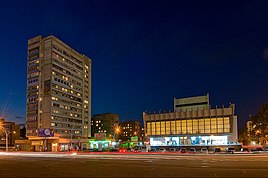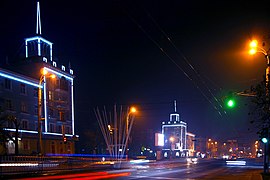Luhansk
Luhansk
Луганськ Lugansk | |
|---|---|
City | |
Park of the Heroes of the Great Patriotic War, Museum of local history, Academic Russian Drama Theatre, Radianska Street, and Luhanskteplovoz steam locomotive | |
|
Dfa |
Luhansk (
Luhansk served as the administrative center of
History
Founding and early history

The city traces its history to 1797 when the British industrialist
The factory was built in the
The factory was greatly expanded during the
In summer 1896, German industrialist Gustav Hartmann founded a locomotive-building company in Luhansk, which is now Luhanskteplovoz. It became operational in 1900, and soon produced a large proportion of all locomotives in the Russian Empire.[4]
In the Soviet Union
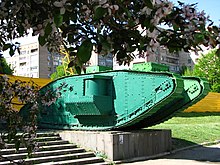
Luhansk was economically devastated by the
After the end of the war, the victorious
The economic recovery and development of the city was also accompanied by significant demographic change. The population grew from 72,000 to 212,000 between 1926 and 1939, and there was an influx of
Voroshilovgrad became a frontline city in
In the postwar period, the city was rebuilt. The population recovered and grew, again alongside demographic change. More Russians were brought in to rebuild and help with
Demographic shifts continued during the late Soviet period; by 1989, Ukrainians made up 41.8% of the population and Russians had a majority of 52.4%.
Ukrainian independence
Ukraine gained its independence from the Soviet Union in 1991. In 1994, a consultative referendum took place in Donetsk Oblast and Luhansk Oblast, with around 90% supporting the Russian language gaining status of an official language alongside Ukrainian, and for the Russian language to be an official language on a regional level.[9]
The previous demographic trends reversed in independent Ukraine; by 2001, Ukrainians - who increasingly spoke Russian - were 50% of the population and Russians made up 47%. The population as a whole began to decline as the economy stagnated, dropping from 505,000 in 1992 to 424,000 in 2014.[2]
Russo–Ukrainian War

In April 2014,
In August 2014, Ukrainian government forces completely surrounded rebel-held Luhansk.
After the Ilovaisk counteroffensive, LPR forces regained Lutuhyne and other Luhansk suburbs. Ukrainian forces withdrew from the Luhansk International Airport on 1 September 2014, after heavy fighting.[18] Human Rights Watch reported high civilian casualties in and around the city, recording over 300 civilian deaths caused by explosive weapons between May and September 2014.[19] The temporary administration of Luhansk Oblast was moved to Sievierodonetsk by the government of Ukraine.[citation needed]
On 21 November 2017, armed men in unmarked uniforms took up positions in the center of Luhansk in what appeared to be a power struggle between the head of the republic Igor Plotnitsky and the (sacked by Plotnitsky) LPR appointed interior minister Igor Kornet.[20][21] Media reports stated that the Donetsk People's Republic, a parallel Russian-backed entity in neighboring Donetsk Oblast, had sent armed troops to Luhansk the following night.[20][21] Three days later the website of the separatists stated that Plotnitsky had resigned "for health reasons. Multiple war wounds, the effects of blast injuries, took their toll."[22] The website stated that security minister Leonid Pasechnik had been named acting leader "until the next elections."[22]
On September 30, 2022, during the
Administrative divisions
This section needs to be updated. (February 2023) |

- Artemivskyi District
- city of Oleksandrivsk
- urban-type settlement Katerynivka
- Kamiano-Bridskyi District
- Zhovtnevyi District
- Leninskyi District
Higher education
Some of the more prestigious universities in Ukraine have their home in Luhansk. Luhansk is the location of the main campus of the
Demographics
In the
Sport
Luhansk is home to Zorya Luhansk which now plays in the Ukrainian Premier League annual football championship and plays at the Avanhard Stadium. The club won the 1972 Soviet Top League.
The other football team was Dynamo Luhansk.
Merheleva Ridge
On 7 September 2006, archaeologists in Ukraine announced that an ancient structure had been discovered near Luhansk, which the press reported as a pyramid antedating those in Egypt by at least 300 years. The stone foundations of the structure were said to resemble Aztec and Mayan pyramids in Mesoamerica. It was later concluded that the site in question was not a pyramid but was still of great interest.
Geography
Climate
Luhansk has a hot summer humid continental climate (Köppen Dfa). Luhansk has both the highest and lowest temperature recorded in Ukraine. A record high of 42.0 °C (107.6 °F) was recorded on 12 August 2010, which is the highest temperature to have ever been recorded in Ukraine.[25][26] A record low of −41.9 °C (−43.4 °F) was recorded on 8 January 1935.[27]
| Climate data for Luhansk | |||||||||||||
|---|---|---|---|---|---|---|---|---|---|---|---|---|---|
| Month | Jan | Feb | Mar | Apr | May | Jun | Jul | Aug | Sep | Oct | Nov | Dec | Year |
| Record high °C (°F) | 12.8 (55.0) |
17.3 (63.1) |
23.1 (73.6) |
31.8 (89.2) |
36.6 (97.9) |
39.4 (102.9) |
40.5 (104.9) |
42.0 (107.6) |
36.8 (98.2) |
31.2 (88.2) |
22.8 (73.0) |
15.6 (60.1) |
42.0 (107.6) |
| Mean daily maximum °C (°F) | −1.0 (30.2) |
−0.4 (31.3) |
5.7 (42.3) |
15.6 (60.1) |
22.2 (72.0) |
26.4 (79.5) |
28.7 (83.7) |
28.2 (82.8) |
21.8 (71.2) |
13.9 (57.0) |
5.2 (41.4) |
0.1 (32.2) |
13.9 (57.0) |
| Daily mean °C (°F) | −4.0 (24.8) |
−4.1 (24.6) |
1.4 (34.5) |
9.7 (49.5) |
15.8 (60.4) |
20.1 (68.2) |
22.3 (72.1) |
21.2 (70.2) |
15.3 (59.5) |
8.6 (47.5) |
1.8 (35.2) |
−2.7 (27.1) |
8.8 (47.8) |
| Mean daily minimum °C (°F) | −6.8 (19.8) |
−7.4 (18.7) |
−2.4 (27.7) |
4.2 (39.6) |
9.4 (48.9) |
13.8 (56.8) |
16.0 (60.8) |
14.5 (58.1) |
9.4 (48.9) |
4.0 (39.2) |
−1.3 (29.7) |
−5.5 (22.1) |
4.0 (39.2) |
| Record low °C (°F) | −41.9 (−43.4) |
−36.9 (−34.4) |
−27.3 (−17.1) |
−12.1 (10.2) |
−8.2 (17.2) |
−1.8 (28.8) |
5.2 (41.4) |
−0.4 (31.3) |
−7.2 (19.0) |
−16.3 (2.7) |
−26.3 (−15.3) |
−29.6 (−21.3) |
−41.9 (−43.4) |
| Average precipitation mm (inches) | 36.0 (1.42) |
35.7 (1.41) |
31.8 (1.25) |
31.4 (1.24) |
46.3 (1.82) |
63.3 (2.49) |
64.2 (2.53) |
36.3 (1.43) |
45.3 (1.78) |
34.8 (1.37) |
39.2 (1.54) |
39.7 (1.56) |
504.0 (19.84) |
| Average rainy days | 10 | 8 | 11 | 14 | 13 | 14 | 12 | 8 | 11 | 11 | 13 | 10 | 135 |
| Average snowy days | 17 | 16 | 10 | 1 | 0.1 | 0.03 | 0 | 0 | 0.1 | 1 | 7 | 16 | 68 |
| Average relative humidity (%)
|
83.2 | 80.3 | 75.2 | 64.0 | 61.6 | 63.8 | 63.7 | 61.3 | 67.8 | 74.9 | 83.3 | 84.4 | 72.0 |
| Mean monthly sunshine hours | 47.2 | 73.8 | 131.1 | 177.6 | 274.9 | 287.4 | 305.5 | 291.4 | 210.6 | 135.4 | 59.4 | 39.0 | 2,033.3 |
| Source 1: Pogoda.ru.net[28] | |||||||||||||
| Source 2: World Meteorological Organization (precipitation, humidity, and sun)[29] | |||||||||||||
Notable people
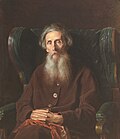
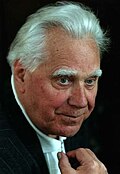
- Vladislav Anisovich (1908–1969) a Russian and Soviet painter and art educator
- Vladimir Bobrov (1915–1970) a Soviet fighter pilot and flying ace
- Nadiya Bychkova (born 1989) a Ukrainian-Slovenian ballroom and Latin American dancer
- polyglot
- Dov Feigin (1907-2000) an Israeli sculptor.
- Pavel Luspekayev (1927—1970) a Soviet actor
- Yulia Malinovsky (born 1975), Israeli politician
- Mikhail Matusovsky (1915–1990), Soviet poet, songwriter
- Julia Rysina (born 1989) stage name T-DJ Milana, DJ, composer, dancer and model
- Leonid Pasechnik (born 1970) leader of the self-proclaimed Luhansk People's Republic.
- Igor Plotnitsky (born 1964) former leader of the self-proclaimed Luhansk People's Republic.
- Andriy Portnov (born 1973) a Ukrainian lawyer and politician.
- Aleksandr Ptushko (1900–1973) a Soviet animation and fantasy film director
- Nikolay Shmatko (1943–2020), sculptor, professor and painter
- Tatyana Snezhina (1972–1995) a Russian poet and singer-songwriter.
- Kostiantyn Sytnyk (1926–2017) a Ukrainian and Soviet scientist and academician
- Kliment Voroshilov (1881–1969), Soviet military commander
- Yevheniy Yevtukhov (born 1984) stage name DJ Sender a Ukrainian DJ, music producer, songwriter and singer


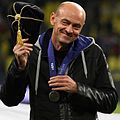
Sport
- Sergey Andreyev (born 1956) a football manager and a former player with 617 club caps and 26 for the Soviet Union
- Valeriy Brumel (1942–2003), a Soviet high jumper; silver medallist at the 1960 Summer Olympics and gold medallist at the 1964 Summer Olympics
- Viktor Bryzhin (born 1962) a former sprinter, team gold medallist at the 1988 Summer Olympics.
- Yelyzaveta Bryzhina (born 1989), sprinter, team bronze medallist at the 2012 Summer Olympics
- Sergey Bubka (born 1963), Soviet and Ukrainian pole vaulter, former World Record holder, and gold medallist at the 1988 Summer Olympics
- Vasiliy Bubka (born 1960), Soviet and Ukrainian pole vaulter
- Fedor Emelianenko (born 1976), Russian heavyweight mixed martial arts and judoka
- Vyacheslav Glazkov (born 1984) boxer, bronze medallist at the 2008 Summer Olympics
- Irina Kirichenko (1937–2020) a Soviet sprint cyclist
- Serhiy Malyi (born 1990) footballer with over 150 club caps and 46 for Kazakhstan
- Viktor Onopko (born 1969), Russian football player with 462 club caps and 109 for Russia
- Sergei Semak (born 1976), footballer and manager with 552 club caps and 65 for Russia
- Andriy Serdinov (born 1982), butterfly swimmer, bronze medallist at the 2004 Summer Olympics.
- Oleh Shelayev ( born 1976) footballer with over 400 club caps and 36 for Ukraine
- Anton Shoutvin (born 1989), Israeli basketball player
- Tetyana Skachko (born 1954) long jumper, bronze medallist at the 1980 Summer Olympics
- Tetyana Tereshchuk-Antipova (born 1969), hurdler, bronze medallist at the 2004 Summer Olympics
- Sergei Yuran (born 1969), football player with 276 club caps and 25 for Russia
- Oleksandr Zavarov (born 1961), Soviet and Ukrainian football player and coach with over 450 club caps and 41 for the Soviet Union
International relations
Luhansk is
 Cardiff, United Kingdom[30][31]
Cardiff, United Kingdom[30][31] Lublin, Poland[31][32]
Lublin, Poland[31][32] Székesfehérvár, Hungary[31][33]
Székesfehérvár, Hungary[31][33] Daqing, China[31][34]
Daqing, China[31][34] Saint-Étienne, France[31][35]
Saint-Étienne, France[31][35] Pernik, Bulgaria[31]
Pernik, Bulgaria[31]
Gallery
During 2014 and 2015, Luhansk has been the scene of intense fighting and most of these buildings are damaged to some extent. Some may be destroyed.
-
Luhansk University
-
Radianska Street at night
-
Luhansk Hotel
-
St. VolodymyrCathedral
-
Soviet buildings in the central city
-
City old hospital
-
Luhansk Drama Theatre
-
A consumer electronics and appliance store, heavily damaged as a consequence of the Russo-Ukrainian War.
-
Monument to the Revolution Heroes
See also
- Luhansk Airlines
- Luhansk Airport
- Luhanskteplovoz
- Merheleva Ridge
- Aviation Technical Museum (Luhansk)
References
- ^ Чисельність наявного населення України на 1 січня 2022 [Number of Present Population of Ukraine, as of January 1, 2022] (PDF) (in Ukrainian and English). Kyiv: State Statistics Service of Ukraine. Archived (PDF) from the original on 4 July 2022.
- ^ a b c d e f g h i j k l "Luhansk". Internet Encyclopedia of Ukraine. Retrieved 16 September 2023.
- Washington Post. 9 May 2014. Retrieved 21 April 2023.
- ^ "ВИНИКНЕННЯ І РОЗВИТОК МІСТА ЛУГАНСЬК". Retrieved 16 September 2023.
- ^ a b "Відновлення луганська після громадянської війни". Retrieved 16 September 2023.
- ^ a b c d "Записки из Якирова Посада – Луганск-Ворошиловград-Луганск". Shusek.livejournal.com. 2 November 2009. Retrieved 16 September 2011.
- ^ a b "ЛУГАНСЬК У РОКИ ВЕЛИКОЇ ВІТЧИЗНЯНОЇ ВІЙНИ". Retrieved 16 September 2023.
- ^ 'Военная Литература' – Биографии – С.Н. Хрущёв ['Military Literature' – Biographies – S. N. Khrushchev] (in Russian). Militera.lib.ru. Retrieved 30 October 2017.
- .
- ^ "Ukraine's Eastern Region Of Luhansk May Now Hold Referendum On Joining Russia". Business Insider. Retrieved 12 May 2014.
- ^ "Ukraine rebels seek to join Russia". 12 May 2014. Retrieved 15 April 2019.
- ^ "East Ukraine city of Luhansk dying under siege, residents say". The Denver Post. 5 August 2014.
- ^ "Ukraine conflict: Under siege in Luhansk". Bbc.com. 13 August 2014. Retrieved 30 October 2017.
- ^ "In Shell-Torn Luhansk, Food and Water Is Scarce: 'Welcome to Hell!'". Newsweek. 15 August 2014.
- ^ Magnay, Diana; Lister, Tim (3 June 2014). "Air attack on pro-Russian separatists in Luhansk kills 8, stuns city". CNN. Retrieved 30 October 2017.
- ^ "Ukraine troops claim breakthrough in battle for rebel city Luhansk". The Guardian. Reuters. 17 August 2014. Retrieved 17 August 2014.
- ^ a b "Lithuania envoy killed in Luhansk". BBC News. 22 August 2014. Retrieved 22 August 2014.
- ^ "Ukraine crisis: Troops abandon Luhansk airport after clashes". Bbc.com. 1 September 2014. Retrieved 30 October 2017.
- ^ "Ukraine: Rising Civilian Toll in Luhansk". 1 September 2014. Retrieved 17 September 2023.
- ^ a b "Kremlin 'Following' Situation In Ukraine's Russia-Backed Separatist-Controlled Luhansk". Radio Free Europe/Radio Liberty. 22 November 2017. Archived from the original on 22 November 2017. Retrieved 22 November 2017.
- ^ a b "Luhansk coup attempt continues as rival militia occupies separatist region". The Independent. 22 November 2017. Archived from the original on 1 November 2020. Retrieved 28 January 2018.
- ^ Radio Free Europe(24 November 2017)
- ^ "Putin Signs Independence Decrees in Precursor to Seizing Ukrainian Regions". Radiofreeeurope/Radioliberty.
- ^ "All-Ukrainian Population Census '2001". State Statistics Committee of Ukraine.
- ^ Кліматичні рекорди (in Ukrainian). Central Observatory for Geophysics. Archived from the original on 4 August 2016. Retrieved 4 August 2016.
- ^ Masters, Jeff. "Bolivia ties its all-time heat record". Weather Underground. Dr. Jeff Masters' WunderBlog. Archived from the original on 24 November 2010. Retrieved 23 November 2010.
- ^ "Кліматичні рекорди" (in Ukrainian). Central Observatory for Geophysics. Archived from the original on 4 August 2016. Retrieved 4 August 2016.
- ^ Погода и климат [Weather and climate] (in Russian). pogodaiklimat.ru. Archived from the original on 12 July 2014. Retrieved 30 November 2015.
- ^ "World Meteorological Organization Climate Normals for 1981–2010". World Meteorological Organization. Archived from the original on 17 July 2021. Retrieved 18 July 2021.
- ^ "Cardiff's twin cities". Cardiff Council. 15 June 2010. Archived from the original on 9 June 2011. Retrieved 10 August 2010.
- ^ a b c d e f "History of Luhansk". Official site of Luhansk City Council. 15 October 2012. Archived from the original on 17 August 2017. Retrieved 10 June 2015.
- ^ "Miasta Partnerskie Lublina" [Partner Cities of Lublin]. Lublin.eu (in Polish). Lublin. Archived from the original on 16 January 2013. Retrieved 7 August 2013.
- ^ "Partnervárosok Névsora Partner és Testvérvárosok Névsora" [Partner and Twin Cities List]. City of Székesfehérvár (in Hungarian). Archived from the original on 8 December 2012. Retrieved 5 August 2013.
- ^ "大庆市与乌克兰卢甘斯克市的往来纪实". 大庆市外事侨务网站. Archived from the original on 11 May 2015. Retrieved 14 July 2014.
- ISBN 978-1-135-10715-4. Retrieved 9 June 2015.
External links
 Media related to Luhansk at Wikimedia Commons
Media related to Luhansk at Wikimedia Commons Luhansk travel guide from Wikivoyage
Luhansk travel guide from Wikivoyage- Official website of the Luhansk city council
- Former website of the Luhansk city council (last updated July 2015) Archived 20 April 2009 at the Wayback Machine
- Topographic map 1:100 000



